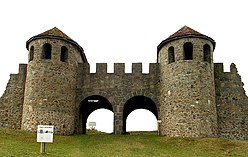| Porolissum | |
|---|---|
 The rebuilt Praetorian gate (Porta Praetoria) | |
| Alternative name(s) | Porolisso,[1] Porolisson,[1] Paralisum,[2] Paralissum [2] |
| Known also as |
|
| Founded during the reign of | Trajan |
| Founded | c. 106 AD |
| Attested by | Tabula Peutingeriana |
| Previous fortification | Dacian hillforts of Pomet hill and Măgura hill |
| Place in the Roman world | |
| Province | Dacia |
| Administrative unit | Dacia Porolissensis |
| Administrative unit | Dacia Superior |
| Limes | Porolissensis |
| Directly connected to | Certiae, (Jac), (Tihău) |
| Structure | |
| — Stone structure — | |
| Size and area | 230 m × 300 m (6.9 ha) |
| Wall thickness | 1.80 ÷ 2.50 m [3] |
| Construction technique | Opus incertum[3] |
| — Wood and earth structure — | |
| Size and area | 225 m × 295 m (6.6 ha) |
| Shape | Rectangular |
| Stationed military units | |
| — Legions — | |
| III Gallica, IV Flavia Felix, V Macedonica, VII Gemina Felix, XIII Gemina | |
| — Cohorts — | |
| I Augusta Ituaeorum sagittaria, I Hispanorum, I Ulpia Brittonum, II Dacorum, III Campestris, III Delmatarum equitata, V Lingonum, VI Thracum | |
| — Numeri — | |
| Palmyrenorum | |
| Location | |
| Coordinates | 47°10′45″N 23°09′26″E / 47.1793°N 23.1573°E |
| Altitude | c. 480 m |
| Place name | Măgura Pomăt / Pomet [4] |
| Town | Moigrad-Porolissum |
| County | Sălaj |
| Region | Transylvania |
| Country | |
| Reference | |
| RO-LMI | SJ-I-m-A-04909.01 |
| RO-RAN | 142159.01 |
| Site notes | |
| Recognition | |
| Condition | Ruined, some parts are reconstructed |
| Excavation dates | 1970 – 1977, 2009 – today |
Porolissum was an ancient Roman city in Dacia. Established as a military fort in 106 during Trajan's Dacian Wars, the city quickly grew through trade with the native Dacians and became the capital of the province Dacia Porolissensis in 124. It is one of the largest and best-preserved archaeological sites in modern-day Romania from the Roman Era. It is 8 km away from the modern city of Zalău, in Moigrad-Porolissum village, Mirsid Commune, Sălaj County.

- ^ a b Schütte, Gudmund (1917). "Ptolemy's maps of northern Europe, a reconstruction of the prototypes". The Royal Danish Geographical Society. Retrieved 2013-05-04.
- ^ a b Dana, Dan; Nemeti, Sorin (2014-01-09). "Ptolémée et la toponymie de la Dacie (II-V)". Classica et Christiana. p. 18. Retrieved 2014-03-30.
- ^ a b "Defensive Strategies And Trans-Border Policies At The Lower Danube – Porolissum". Archived from the original on 2012-03-16. Retrieved 2011-04-17.
- ^ "Situl arheologic roman de la Moigrad-Porolissum – Dealul Pomet". National Archaeological Record of Romania (RAN). ran.cimec.ro. 2014-01-07. Retrieved 2014-03-20.
